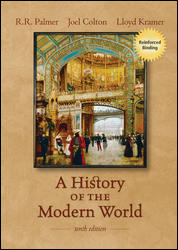 
History of the Modern World, 10th Edition (Palmer)Chapter 11:
Industries, Ideas, and the Struggle for Reform, 1815-1848Learning ObjectivesChapter 11 teaches students about:
The rise of industrial society within the capitalist system. |
 |  |  |
The innovations in agriculture, industry, and transportation that led to the industrial revolution that took place in Britain. |
 |  |  |
The social consequences of the industrial revolution. |
 |  |  |
The proliferation of doctrines and movements after 1815, most notably, laissez faire political economy, Romanticism, liberalism, radical republicanism, socialism, feminism, and nationalism. |
 |  |  |
The emergence of cultural nationalism as a program for political action, especially where people of the same nationality were subject to foreign rule. |
 |  |  |
The fear of revolution after Napoleon's defeat, which led to the entrenchment of reactionary policies. |
 |  |  |
The congresses of the Great Powers, which were the initial experiments with a system of international regulation by the European countries. |
 |  |  |
The seeming containment of the revolutionary forces unleashed by the French Revolution, some ten years after Napoleon's defeat. |
 |  |  |
The successful resurgence of nationalism and revolution in France, Belgium, and Poland after 1830. |
 |  |  |
The ambiguous impact of the Reform movement in Britain. |
 |  |  |
The golden age of the bourgeoisie and their influence upon Europe, especially Britain. |
 |  |  |
The estrangement of labor during the bourgeois age, and the rapid spread of socialism among the working classes. |
 |  |  |
The growing divide between western Europe's liberalism and eastern Europe's autocratic monarchies. |
 |  |
|





